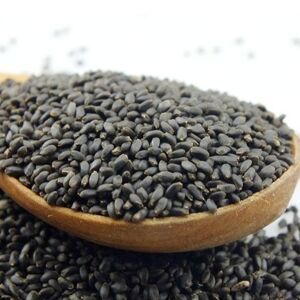
Sesame Seeds
Sesame is grown mainly for its oil-rich seeds, which come in a variety of colors, from cream-white to charcoal-black. In general, the paler varieties of sesame seem to be more valued in the west and middle east, while the black varieties are prized in the far-east.the sesame seed is used full in cooking for its rich nutty flavor and also yields oil. The ground and processed seeds can also be used in sweet confections. Sesame seeds are also added to breads and at the tops of hamburger buns. The seeds known to be quite rich in many mineral contents like iron, magnesium, manganese, copper, and calcium. The seeds are also a good natural source of vitamin b1 and vitamin e.
...more
Nigella Sativa
Nigella Sativa is variously called as Black Seeds, Black Onion, Black Cumin Seeds, Roman Coriander or Kalonji. Nigella Seeds are small, Matte- black seeds with rough surface and an oily white interior. The seeds of Nigella sativa are used as a spice in Indian and Middle Eastern cuisines. The black seeds taste like a combination of onions, black pepper and oregano. The dry-roasted nigella seeds flavor curries, vegetables and pulses. It can be used as a "pepper" in recipes with pod fruit, vegetables, salads and poultry.
...more
Mustard Seeds
Mustard was used by the Romans as a spice for the first time. It is commonly called ‘sarson’ in India. The genus Brassica consists of over 150 species of annual or biennial herbs several of which are cultivated as oil seed crops like mustard. Other oil seed crops in genus are toria and rapeseed. There are many other, which are cultivated mainly as vegetable like cabbage, collies flower, turnip etc.They are extensively used for cooking as well as in various food processing units. They are used for extracting edible oil used for preparation of almost all kinds of dishes. The oil obtained from the mustard seeds is of highest quality and standard.
...more
Millets
Small Millets were a major constituent if crop diversity in India. The high nutritional compositions of these are now coming to light the world over. Millets have tremendous capacity to grow in dark rocky lands and also have high straw index which is beneficial for livestock.
...more
indian organic spices
Amaranth has been cultivated as a grain for 8,000 years. Due to its nutritional characteristics, it is predestinated for alternative food applications and health-oriented nutrition. The sweet, nutty flavour enriches the conventional segment of cereals. As the interest in specialty products for bread, muffins, pasta, muesli and snacks is growing, Amaranth is an attractive innovation suitable for all cooking and baking styles.
...more
Flax Seeds
Flax Seed (also known as flax or linseed), Linum usitatissimum, is a member of the genus Linum in the family Linaceae. It is a crop cultivated in cooler regions of the world. Flaxseed is found in all kinds of today's foods from crackers to frozen waffles to oatmeal. Although flaxseed contains all sorts of healthy components, it owes its primary healthy reputation to four of them:Flaxseeds are High in Antioxidants (Lignans). Flaxseed contains 75 to 800 times more lignans than other plant foods.
...more
Basil Seeds
The black and tear-shaped seeds that many confuse with chia seeds are rich in proteins, carbs, and essential fats and are packed with a good deal of fiber. Interestingly, these seeds of the basil plant contain no calories. Basil seeds are rich in antioxidants, help in controlling diabetes and is also good for your skin.Basil seeds are most nutritious when soaked in water and consumed. They begin to swell at the touch of water, with a translucent white film coating each black seed, and they become twice their size. You can soak about two teaspoons of seeds in one cup of warm water for about 15 minutes. Warm water causes the seeds to fully swell up releasing antioxidants and beneficial digestive enzymes. These fragrant seeds do not really have a distinct taste and can be added to a variety of dishes for a nutrition boost.
...more
AMARANTH
Amaranth has been cultivated as a grain for 8,000 years. Due to its nutritional characteristics, it is predestinated for alternative food applications and health-oriented nutrition. The sweet, nutty flavour enriches the conventional segment of cereals. As the interest in specialty products for bread, muffins, pasta, muesli and snacks is growing, Amaranth is an attractive innovation suitable for all cooking and baking styles. The recent attention given to Amaranth is due to its extraordinary nutritional value. The grain has a protein content of 12 to 17 percent and a high content of the essential amino acid lysine, which can hardly be found in other cereals. The grain has a high fibre content and is low in saturated fats. Amaranth is rich in iron and calcium as well as other vitamines and minerals. Amaranth has a high lysine, methionine and cysteine content. The essential amino acids in amaranth are in well-balanced relation to each other. This nutritional balanced and richness is of central importance for vegetarians. A low content of sodium and the absence of saturated fats continue the list of positive attributes. Like Quinoa, Amaranth is also suitable for a gluten-free diet.
...more
Amaranth Seeds

Cumin Seeds

Fennel Seeds

Fenugreek Seeds

mastard seeds
Be first to Rate
Rate ThisOpening Hours